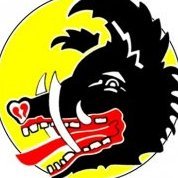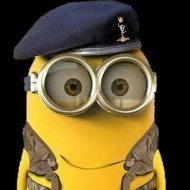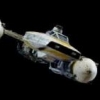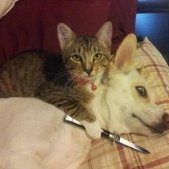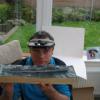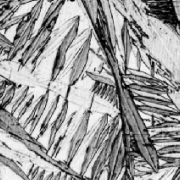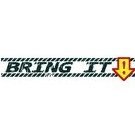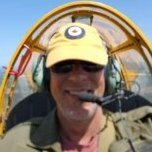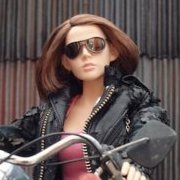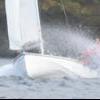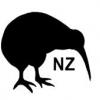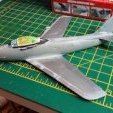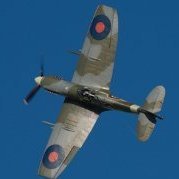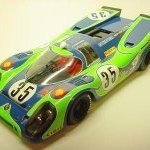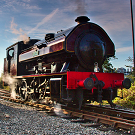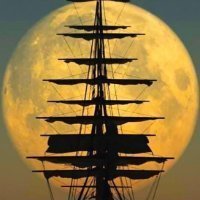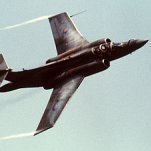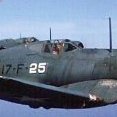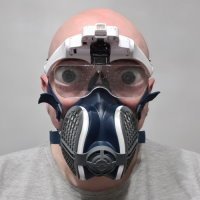Leaderboard
Popular Content
Showing content with the highest reputation on 29/09/21 in all areas
-
Hello all. I’ve been beavering away with this one for the past six months in the WIP area and its now finished. If you would like to check out the build here is the link. As per usual the Amonster kit comes with the fuselage and main wings moulded in glass fibre, the rest in (short run) plastic. The model has a scratch-built Novella housing as the kit offering was the wrong size and shape. The windscreen wipers are from an Ace etch fret. The decals are from Begemot sheets other than the flags which I made, and the colour is home mixed. The model weighs in at a hefty 485 grams, most of it in the front end to stop it being a tail sitter. I’ve included a couple of pics with my Nimrod for size comparison. Hope you like it. Thanks for looking. Pete33 points
-
Ye Olde FROG Hellcat. Fun with old plastic. I'm sure we all know this classic..... It does need a little help to make look acceptable. Mainly fix the canopy, adjust wing dihedral, and lengthen the landing gear. I lengthened the sliding portion and shortened the windscreen. I enlarged the windows behind the sliding portion and will fill those with clear window maker. Wings were glued on at correct angle and filled. Rather than lengthen the struts that I have mostly had little success with, I just lowered the mounting holes with square styrene. Print-Scale Decals were used for Lt(jg) Alexander Vraciu of the USS Intrepid, February 1944. My own mixtures for the U.S. Navy colors using MMP paints that performed very well. All out-of-box except the canopy and decals...and the gun sight. I think I could have gone a little heavier with the weathering, they got fairly nasty out there on the carriers. Next to the several Spitfires on the shelf, this was genuinely a big aircraft. Thanks for following along this long.31 points
-
Thought I`d put some sunny photo`s up to counter the rain and coincidently show you my latest completion which kills two birds with one stone🙂 My attempt at Eduards 1/48 VLR Mustang from the `Tales from Iwojima` boxing Built almost completely OOB ,I did leave some bits of PE out and some pinged off into the carpet monster ( which is weird, as there isn`t a carpet in the kitchen ? ) Had a hard time choosing from the many colourful options provided and in the end just went for the first one in the instruction booklet. So in the markings of `Annie Lee` which was flown by Lt Col John W Mitchell who has fame by leading the mission against Yamamoto, April.... 1943 which resulted in his demise. Only thing I had to add was some wire brake pipes Suppose now I`ll have to pick up some weekend editions so I can make a few of the others on the decal sheet🙂 Hope you enjoy the sunny pic`s, thanks for looking Cheers Russ22 points
-
Although they flew in full livery, Sabena’s BAe-146s and Avro RJs were actually operated by Delta Air Transport (DAT) which would later form the nucleus of Brussels Airlines following the collapse of Sabena in 2001. Here is the Revell BAe-146-200, one of my favourite airliner kits, finished as OO-DJJ circa 1996. OO-DJJ was delivered new to DAT in 1991 and apart from a brief lease to Malmo Aviation in 2003/4 served until 2007. She is now a water bomber fighting fires with Neptune Aviation Services in the USA. The Revell BAe-146 is a straightforward and enjoyable build apart from the rather fiddly undercarriage. The cabin window line is slightly too high and the windows are too small which isn't a big deal if you use decals. l placed the window decals about 1mm lower for better alignment with the large titles. Paint is overall Halfords white. Decals are by Daco with Authentic Airliners windows. In 1996 OO-DJJ and some other DAT BAe-146s were decorated with “Suske and Wiske” (aka Spike and Suzy and other names depending on country) to celebrate 100 years of Belgian cartoon strips. Apparently there were plans for Tintin to feature on the Avro RJs but copyright issues got in the way. Thanks for looking and constructive criticism is welcome. Dave G With the Sukhoi SSJ-100, a later and much less successful recruit to the Belgian national carrier18 points
-
17 points
-
G'day All The second of my Harrier triple builds, this one is Kinetics new AV-8A. Overall, an easier build than the FA2. Kinetic have retooled the fuselage and the intakes so they fit a lot nicer now. Kinetic have also moulded some cockpit sidewall detail into the fuselage halves too. I was happier with how this turned out compared to the FA2. As a contrast. I decided to do this one as a clean build, rather beaten up. Decals came from the kit, with paints coming from Mr Color and AK real colours. Decals were from the kit. Eduard supplied the seat straps and the LAU-10 rocket pods. The third and final Harrier is almost ready for paint, and I think that will e me and harriers for a while! Thanks for looking Bruce17 points
-
Hi Mates, Finished a F-5A from Classic Airframes recently. Thought it would be nice to make it from a lesser know F-5 user, Libya. The operational life of the F-5 in the Royal Libyan air force was a short one due to the coup from Gaddafi in 1970. Couple of the machines were sold to Turkey I believe. The kit is OOB except for most of the decals, the Libyan markings are from ArmyCast and the stencils came from the CA kit and from a spare Kinetic kit F-5 decals. Oh, and the pitot is from Master. The build process can be seen here; https://www.scalemates.com/profiles/mate.php?id=14213&p=albums&album=72174 Erik16 points
-
Hi all - after spending a year spent building the Dynavector Scimitar I needed a mojo restorer and this kit did the trick for me - it went together in a couple of months and makes an impressive model even just out of the box. I relied heavily on Antti_k's WIP of his Javelin and the BM walk arounds on the Javelin. The only area that gave me any concern was joining the nose of the model to the main body of the aircraft which was probably self inflicted - the ejection seats did not have any harness but I thought they looked quite good so decided to make my own harnesses - Ejection seat harnesses are a bit of a mystery to me, I tried unsuccessfully to print the harness like Antti_k showed in his WIP but ended up using strips of foil cut from a Ferrero Rocher chocolate wrapper and a set of 1/48 buckles etched by L'Arsenal of France. What you see is my artistic impression of the jumble of belts on an ejection seat especially on the seat part. canopy strips were from an Xtradecal stripes sheet - can see a bit of touch up needed below I added wheel chocks and fire extinguisher from a Flightpath RAF diorama set Thanks CJP12 points
-
As it turns out, there is quite a bit of the photoetch for the Revell F-14D that I can use in this build. For instance, the air conditioning vents (I think that's what they are): I tried to hold the bulkhead at an angle that would show the PE vents the best. There are a few more things I can use in the cockpit, and quite a few for the fuselage and landing gear. As far as the cockpit goes, I managed to get that and the ejection seats finished up. I used the decals supplied by Fine Molds for the instrument panels and side consoles and I have to say they have that Hasegawa-Tamiya-Fujimi decal syndrome. In other words, gallons of decal solvent was needed to get them to conform. I'm not entirely happy with how it looks, but at least it looks better in real life! These enlarged photos don't do it justice. Control column and radar joystick will get added much later... And the other view, showing the thousands of circuit breakers on the rear bulkhead. I just applied a wash to make them stand out a bit more - they are quite nicely moulded. The ejection seats were enhanced with PE harnesses from the spares box but otherwise are as supplied with the kit. The seat frames are, of course, black in real life. I've seen some folks who spray the seats black and then apply a grey wash to highlight details. I always thought this looked odd - shadows shouldn't be lighter than the object. So I sprayed the seats a dark grey (Tamiya NATO Black) and then applied a jet black wash - I think it looks more realistic. But what do I know? I'm just an old geezer. Here the seats are posed in the pit: Next, I'll add some additional details for the sidewalls and get the nose section closed up - Fine Molds supply nothing here. In any event, she's finally started. Cheers, Bill PS. Our local club had their annual contest yesterday. I rented a table in the vendor area and sold about one third of my stash. I didn't want to, but there is just no way I'm ever going to build all this stuff. Not unless I live to 152! I did OK in the contest. The big shocker was my 1:72 F/A-18 CONA Hornet taking a Gold and winning Best Aircraft. I guess my description of making all the Aires resin fit the kit got me the sympathy vote! What else? My Tucano took Gold, my Firebrand got a Silver (they were in the same category), my DH.88 got a Silver, and my 1:32 Spitfire IXC won Best of the Masters. My Martin Mauler struck out - just like the real aircraft!12 points
-
This is my 1/48 scale Royal Canadian Air Force Piasecki H21C Shawnee or more commonly known as "the Flying Banana" A couple of years ago I had a period of interest in helicopter models and I wanted to build the Flying banana because of its curious looks and the colourful Canadian scheme. This helicopter type was widely used in the 1950's by the US army, and especially at the beginning the 1960's in the Vietnam war. This chopper was introduced in the maple leaf country in 1954 and its special assignments were search and rescue missions and special tasks in the Arctic areas. Because of the winterization of the chopper it could operate in sub-zero temperatures as low as -54 degrees centigrade. I built the model from a 1/48 scale Italeri kit which was quite ok, but not reaching tamigawa quality, though. There were some fit issues and quite a bit of sink marks and some flash. The RCAF decals for the colourful helicopter are from Belcher bits and I also used an Eduard photoetch set to enhance the details.11 points
-
I completed these two aircraft earlier this summer, about two months into my reentry to the hobby after a 20 year hiatus. Both are in 1/72. The Academy P-51B was only my fourth model since that restart, and was completed out of the box with the addition of Eduard seatbelts. The finish is a combination of Tamiya and Testors rattle cans, and brushed acrylics from Tamiya and Vallejo. All in all, I think it was a success and I learned enough that I wanted to give another ago, but this time with an Airbrush. I purchased an Iwata Neo and a compressor and set my sights on a bubble-top P-47. The P-47 is made from Tamiya's 1/72 boxing and likewise built out of the box with the addition of Eduard seatbelts and a few scratch built details in the cockpit and engine. Paints were a combination of Tamiya and Vallejo acrylics and Vallejo's Metal Color. P-51B-7-NA s/n 43-7040, in 1/72 scale. The original 43-7040 was built in 1943 at the North American Aviation plant in Inglewood, California. She was given the code E9-Y, assigned to the 376th Fighter Squadron, 361st Fighter Group, of the 8th Air Force and operated out of Southern England primarily on long range escort missions for USAAF bombing missions. She was painted with invasion stripes just prior to the invasion of Normandy and flew in support of the allied advance through France and Belgium. Never having been given a name or any nose art, she was likely a rotating spare for the squadron's pilots, something of an unsung, unadorned hero. After over a year of service 040 was declared "War Weary" and transferred to the 434th FS. With her invasion stripes removed, and re-coded L2-3, she was used as a "squadron hack", for training and other non-combat flights while she awaited the end of the war, and her final trip to the scrap yard. The markings for my model were pieced together from various kit and aftermarket decal sets. P-47D-27-RE s/n 42-27215 was assigned to the 379th Fighter Squadron, 362nd Fighter Group, 9th Air Force, and was the charge of Lt. Ralph Sallee, who named her "Super Rabbit" While flying a close air support mission over Bastogne, the day after Christmas 1944, a small flight of the 362nd's P-47s spotted a group of 25 German Fw. 190s at treetop level. Without hesitation, they jettisoned their bombs and dove strait down into the German fighters. In the next hour and twenty minutes a running battle ensued and Sallee claimed two of the eight Fw.190s shot down that day. Ralph Sallee never forgot the image of one of his adversaries, 40 feet away, slump forward in his cockpit and nose dive into the ground after a burst of .50cal through the canopy. 60 years later, Sallee learned that man to be 29 year old German Lt Heinz Fresia who's remains had then recently been recovered from the crash site. Markings provided by the Barracuda Studios Mogin's Maulers set. Okay, I know they aren't perfect, but they are good enough that I'm not scared of doing another NMF aircraft. Its gotta get better the more I do it...11 points
-
Thanks for the kind comments fellas,...... and sorry for the gap in coverage,..... life sort of got in the way again, plus I`ve been deciding on schemes etc for all three kit. Here is where I am at,..... sort of; 1- The original Airfix kit,..... B.35 using the Freightdog set; Here is the set cleaned up and test fitted,...... when pressed down it is a perfect join,..... but I`m not using the full set in this case; I`ve decided to have the bomb doors fitted open, so the kit doors were sanded smooth,.... the left hand door seen here has yet to be sanded.; The the rear bulge behind the bomb bay of the resin set was then cut from the rest of the Freightdog part and attached to the model, alongside the bomb bay interior rear wall. The resin rear wheel has also been attached too, I need to refer to the instructions and reference photos before adding the resin intake on the fuselage wall below the wing and the rear warning radar; 2- Airfix kit,.... built as a PR.XVI; Using the second new Airfix kit,..... I`ve used the flat resin bomb bay doors and the cover behind them from the Freightdog B.XVI(H2S) set to built this model as a PR.XVI. I have also drilled out the camera ports in the rear fuselage plus those in the resin bomb doors,..... and eventually the cockpit access door too; 3- Hasegawa kit with resin engines,..... another PR.XVI,..... using a vacuformed canopy; Like above,..... I drilled out the rear fuelage camera ports and the ports in the bomb bay doors too; So that is it for now,...... still not fully decided on schemes for the PR.XVI`s.....,.... the options being; 1- RAF, SEAC, Silver with blue SEAC bands. 2- RAF SEAC, PRU Blue with dark blue spinners. 3- RAAF, PRU Blue. 4- SAAF, PRU Blue, D-Day stripes and red/white striped fin, yellow spinners. 5- SAAF, Overall Silver, Post Wr 6- USAAF, PRU Blue, Red tailplane. So time to check the decal bank and the references! Cheers for now, Tony10 points
-
Aerocraft Models cowling and Eduard LooK instrument panel.9 points
-
Dornier Do17 Z7 Night Fighter-early conversion by ICM, scale 1/72 This was an OOB build, with a little scratch building to show an engine service, I used ICM's 1/48 instructions to help with this. Very straight forward as is the case with ICM kits. I nice addition to my Dornier heavy night fighter collection. There weren't many of these conversions made and not all were painted overall black, so I picked one plane that was left with upper surfaces in original camouflage scheme as it looks more visually interesting. All the paint work on the fuselage and underside is intentional to show its hastily paint conversion. Anyway I hope you like it.9 points
-
Rounding things off At the end of the last major post we were up to something like this. Things definitely looking a bit Miragish, but still all very blocky and squared off. At this point the damned thing could be made of lego! I will not insult you all by showing how I glued the two fuselage halves together with the tail stuck in between them. Suffice to say, by the time the photo below was taken the bits you can see are firmly glued together with PVA glue. Note the laminated cross-sections in the foreground. Immediately after this photo they were cut out with scissors and were very important in the work to follow. Now we start carving away the blocky square edges that don't conform to the desired cross-sectional shapes. Not much to it really, just work slowly and alternate which side you work on so that you don't end up all lop-sided. In this job symmetry is everything. The average viewer probably wont notice a slight inaccuracy in the profile but the human eye picks up asymmetry instantly. Everyone knows that aircraft are symmetrical. Work slowly and remember that it's always easier to carve more wood off than add wood back, so err on the side of not removing enough. Work slowly peeling off layers of less than 1mm with each stroke of the chisel. BTW, In this view you can also see I've put some filler in the jet nozzle to ensure a nice smooth interior. It might get a bit of detailing later on. Keep checking periodically against the templates. A contour gauge can also be useful during this process. At this point I thought I was 'almost there' but you can see that there's still a lot of carving to go. As we get closer to the final shape we can move to rasps, files and sandpaper. In this regard the process is a bit like woodturning. The 'fast' tools go first and we move to 'slower' tools as we get closer to the final contour. Nice! She's looking OK at this point. I still haven't touched the underside yet; see how the tailpipe is sitting in an arch rather than a circle. Just to give you an idea of how gradually this progressed I reckon that there's about 3 hours carving in this post so far. This is not a hobby for thrill seekers. Flip it over and start again. Rounding off the underside under the tailpipe only took about 30 minutes. Attack the nose in a similar way, starting with marking up the wood to remove with a series of diagonal lines. Topside done - I haven't touched the underside as it risks making the structure under the cockpit floor even thinner and more delicate so I’m going to leave that until as late as possible. And here she goes at this point. Rounded off and looking promising! 👍 The last three photos are taken on my I-phone, their clarity emphasize just how scruffy the photos from my old shed camera have become. I'm aiming to get a new disposable point and shoot in the next week or two so bear with me. I'm especially happy with the circularity of the jet-pipe and surrounding fuselage. I showed Baby Bandsaw and even she with her cynical teenage attitude reckoned it was pretty good. On the underside we can still see the boxy contour under the nose as mentioned above and the fact that the underside of the wing is still dead flat. Just like the rest of the aircraft, the underside needs to be nice and curvey. I'll be dealing with that in the next post. OK Folks that's it for now, thanks very much for all of the interest shown. Best Regards, Bandsaw Steve.9 points
-
Day three.... Lower hull is almost as complete as I'll take it prior to paint, no I can't join the crazies and put everything on prior to paint! RFM has had a few issues with the miss-numbering of parts on this T34, nothing insurmountable just mildly irritating. Otherwise it all goes together really nicely, already looking forward to the paint stage. Upper and lower hull are still separate, for now, just sat in situ. Haven't made a decision on the front fenders yet, if I've got the required tools I'd like to chop them around a bit, make it look a little more "used", how often do you see a pristine straight T34? RFM provide a really nice etch part for the air intakes on the engine deck, unlike some grills that look 2 dimensional this has a nice woven effect. They also provide a plastic alternative if that is your preference. Just to put some of the more vulnerable parts on, horn, lamp, catches etc and then the turret. Exhaust covers will be tacked in situ prior to paint before having the exhaust pipes painted separately. Will need to make a decision on the tracks, Fruils or the link and length jobs provided... (Having a chopping mat the colour of the plastic isn't helpful either...) Thanks for looking Darryl8 points
-
This next bit, although small by comparison with other jobs, was probably one of he most difficult that I've ever done, and that is the small, curved shield, on the rear of the vehicle, just in front of the spare wheel. As well as being curved, the forward edge has to be vertical, whilst the rear edge is about 45 degrees. The way that I tackled this was to cut a circle from 1mm card, the same diameter as the spare wheel. I then lightly glued the paper to the edge of the card around 50% of the circumference. I drew on to the paper where the card edge was and did the same for the rear. This was then removed from the card circle and cut out, and the shape applied to a piece of 10thou card. I cut a rough approximation of the shape and just kept trimming it until I was (reasonably) happy with it. A lot of effort for just one piece, but an important item for this vehicle, as not carried by the Types 2,3 and 4 A/C's. Once that was complete, it was time to find a spare wheel. I had an Italeri one, left over from the Type 4 build. It's not perfect by a long chalk but it'll have to do as I don't have any alternatives. It was only after gluing the two halves together and comparing it with the Hobbyboss ones, that I realised that it was a little on the thin side. If I'd have realised before, I could have sandwiched a disc of card between the two halves. Too late! I drilled out the centre and cut off the bolt heads. Where the bolts had been, I drilled through, but my accuracy was off, and a couple of the holes were on the edge of the centre hole. So I cut a card disc and glued that in place and started again. Once I had the holes where I wanted them, I made a retaining bracket from thin scrap PE. This was glued in place on the inside of the wheel, and bolt heads were added to each end. Next, a couple of support brackets were bent to shape from some wider pieces of scrap PE. These act as the seat that the spare wheel sit in. When I was satisfied with all of the parts, they were glued in place. Again, I've got a little more to add, but I'll save it for another day. Good news is (for me) that Matola have posted the MG34's to me, so I can now make a start on the turret and front gun position. ATB, John.8 points
-
Flattery, oh how I love the scent of flattery. What? That is not FLATtery but the other flat word? Ah got you, I digress again. I can tell you Alan the real shape wasn't far off before we Milliputted, so mostly resolved in the first pass of the Milliwand. The idea is to get the back of the box vertical and with added roundness to get the lovely flying box shape right So! And A second small mix will resolve the minor shape issues and allow the insides to be begun. I had thought about using Green putty instead of Milli, jury's out for now but the floor is being glued into the left fuselage half prior to getting on with the insides. I know the upper cockpit rear looks a trifle unkempt, unruly so to speak, but when it gets the windows carved away and glazing input I think it will be rather nice. If it isn't I still have loads of Milliput... Adios amigos.8 points
-
My conversion of the Airfix 1/32 Beach Buggy (A02412V) to a four-seat, six-wheeler. This was almost never built as I was supposed to opt out of the Beach Buggy GB over on the ATF. However, as soon as I saw some buggy builds, I just had to join in the fun! The only downside to the build were the figures. I HATE painting figures! It has been suggested to me that I do a 4-wheel steering version like the Tyrell F1 car next.... Dave7 points
-
Hi all. I hereby present the finished article that is my 1/48 Revell rebox of the Eduard Fw-190 D-9. Its been quite a while since I had a kit so fraught with problems, and this one did test my patience quite a bit. Fit issues, poor location/keying, incorrect or confusing instructions, and even mis-moulded parts. By some miracle it turned out looking decent. Due to the instructions being contradictory at times, I ended up losing decals to masking tape while painting the tail bands on (decal bands didn't completely reach around the tail. Instructions told me to place the bands over the stencils, but the finished pictures on the manual and box show the stencils over the top, which would have preserved them 🤦♂️ The protruding rod on the right wing came off early, and I hadn't yet reattached it. The dorsal antenna behind the ring shown in the painting instructions didn't exist in the plans (including the Eduard ones) or the sprues, so not sure about that one. Anyway. Glad to finally be done with it, even if the right landing gear keeps wanting to collapse and won't seem to reinforce with glue >< On to the pics. Thanks for looking Gaz7 points
-
Greetings Mates, Hope all is in good spirit. Yes, Zvezda's new C-130J-30 is coming out anytime soon and why am doing this? Well, I had this kit and for a while wanted to make it into the extended version, I tried to get the resin conversion then I realized it is more expensive than the kit itself so time for an experiment. I ordered some stuff from abroad but sadly still stuck in customs so it was pretty much with whatever I have. For the next few days I would read many documents and forums for the required surgeries I realized most is resin conversion, however, there was a C-130H 1/72 conversion that keeping in mind with some reference material I started my endeavor. First I chopped the front and rear then I was wondering how to make the plug I tried some plastic but it won't fit well so make it a square one, as I was measuring the gap and attached a small wooden plank It was my Eureka moment. I cut some wooden plank into small pieces and attached both sides some parts I used a nail plier carboard hehe it was easy to make a curve, then sand and sand the whole say to make a round shape. Then it is tons of epoxy which I let it dried for the night and next two days sand and sand again. It literally exhausted me and since my paints are stuck with the bane department (custom) so back to local paint for which you need some additional works. I have to say this has to be the most exhausting yet learning build in recent time. Will I do it again haha, well NO for this scale, and the saving grace is the Zvezda's kit. Anyways, it is not perfect and there are some errors here and there but tried my best, and here are pictures, thank you for watching any feedback welcome. Cheers7 points
-
Yevgraph Nicolaevich Kruten was born in Kiev in late 1891. Son of a Russian Army Colonel, he entered the Kiev military Cadet Corps at age 11. Fascinated by aviation, he was taken under the wing of Petr Nestorov, known as the first aviator to successfully loop his aircraft. Nestorov recommended the young Artillery officer as an aviation candidate. An excellent pilot, he started the war flying Voisin LAs. By 1916, with tremendous experience, Kruten was now the Second Russian Army Air Detachment Commander (rank of Staff Captain). When Kruten’s detachment began transition to Nieuport 11s inn Feb 1916, Kruten began writing a series of 6 theoretical booklets outlining for inexperienced pilots the rules for successful Air Battle (sort of like a Russian Oswald Boelcke). The booklets defined the assault sequence as: Altitude—Speed—Maneuver—Fire After downing 3 German planes, in Nov 1916, Kruten was selected to join other Russian pilots in France to familiarize themselves with new tactics. He was assigned to Escadrille N.3 under the care of Aces Guynemer and Huerteaux. He downed another German and was awarded the French Croix De Guerre. In Paris when the Czar abdicated, he called it the “Saving Thunderstorm that liberated Russia from the Czarist Regime”. Returning to the Eastern Front in April 1917, he assumed command of the Second Air Group, as Russia fought on under the Kerensky govt. This Group was equipped with Neiuport 17s and 21s. Now LCOL Kruten’s fighters were adorned with a Medieval Knight - a practice he had picked up in France. After scoring a few more victories (6 total), on 19 June 1917 he was returning from a flight when his Nieuport 17 went into a spin and crashed. It is noted that at this point in the war, maintenance of aging Aircraft was starting to plummet as Russian forces began to disintegrate as Revolution spread. Kruten's Awards were: Order of St George, 4th Class, Order of St George, 3rd class (posthumous), Golden Sword of St George, Order of St Anne, 4th class, and Order of St Stanislaus, 3rd and S2nd Class. Kruten's Fatal Accident:6 points
-
Know what you mean Stuart funny how the dark nights turn us in to nocturnal model builders. 🧛♂️ Small progress barrels replaced I think OK and also managed to patch up some of the mould problems with scrap PE fret. Stay Safe beefy6 points
-
Compared to the old four tone Swedish splinter camouflage the style used here is pretty quick and easy to mask, not just because there's one colour less but also since the fields are generally much larger. Though given what I'm comparing with there... I think there's a SPAAG under there somewhere. Masking would probably have been a bit easier if I had gone with the darkest green last, but I went with the lightest (pic above is just before I started removing the masking tape) since that meant I always had a darker background to work with. Whether any of the unevenness I prayed in will remain visible through the weathering remains to be seen. Masking removed. Maybe not entirely surprisingly the forward-left turret lifting eye went AWOL again. Probably can't blame it on transport damage this time... Detail painting done, all four decals added and varnished up for the weathering.6 points
-
I'm working on a 1:96 Revell Constitution I've owned since my senior year of highschool, so like 2015 probably. I've been very slowly but surely working on her since. Now that I have a workspace tall enough for her masts, I aim to finish her soonish. Back then I painted the gun deck with brush and got an ok, if dark, wood look. I painted her with a Royal Navy Ochre stripe then, which I still think looks pretty slick, so I intend to keep it, and whether or not Constitution ever wore a disguise, I know that it wasn't an unheard of practice. the only other things I got done back then were painting the aft cabin, and rigging the open gunports. Last Week I broke her out again, rigged her closed gunports, and all the easily visible cannon on the gun deck, which might I say, I must have been more dexterous six years ago because the tiny knots elude me nowadays, I just superglued the cannon's line to the little posts on the gun deck. Which if anyone has a better suggestion than superglue for the lines I'd love to hear it. the other thing I've done this week is put her spar deck on, prime and paint it, and now I'm attempting to bring some visual interest with a bit of Flory Dark Dirt wash on the butted joins and nail head on deck, and I'm curious if you all think the overall color of my spar deck is good, and also if the wash on the nail heads looks good. Old Photos- Recent Photos -5 points
-
All recently modeled parts were printed and will be ready to fit test after rinsing and curing steps: Serkan5 points
-
It's been a PE sort of day, I have done the foremast. Black primer applied. I will then spray it grey, as per @Gisbod with the hope it'll give a subtle shading effect. The rear face of this assembly will stay black, I haven't figured out how I will achieve this, maybe liquid mask. Probably do something here tomorrow, but then will be away for a few days in Yorkshire. That nearly didn't happen with this petrol panic, but I filled up this morning with no problem. How I'll get back, not sure yet, but this madness can't last much longer. Jon5 points
-
OK. let's start for "about the bad" 1. Wings airfoil along its entire span. The root should be NACA 64A-318. Near ailerons NACA 64A-412. This one, no other. Why on the model it turned out on the lower part of such a curvature as in a jet liner. 2. The engine cross section is narrow at the bottom along the entire nacelles, starting from the oil cooler intake to the very rear end of the nacelle. 3. The exhaust pipes of the engines are 2.5 millimeters less in diameter (Karl !!) than they should be. In an attempt to combine these small pipes with the panel lines and other small elements of the nacelle rear, the developer moved all of them from the correct location. 4. The details of the flaps marked with the panel lines on the lower part of the wings do not coincide along the contour with the prototype (Italeri and Eski had it right) 5. A gathering seam along the back of the wings was made on the lower half. Why didn't they do it on the upper half like the real C-130? 6. Why are all panel lines on the wings stepped? Everything is done exactly on the rest of the model. 7. Many small elements (on the rudder, ailerons, elevators and other surfaces) have been ignored in the panel lines - ESCI have done much more in their time, and then it was much more difficult to obtain information than it is now. 8. Wheels have a strange profile, coinciding with the prototype only in the outer diameter. The brakes are ridiculous and don't look like a prototype. Better to immediately change to resin. 9. the longitudinal plates of the reinforcements along the fuselage are marked only by the panel lines. 10. Branded, Lockhid's kink in the cross section of the lower part of the fuselage was made, but pulled it under the cockpit (it was necessary to bring it only to the front front door) 11. The front parts of the sponsons of the main chassis wheels in the "late or wide" version differ in appearance from the prototype. 12. Optical turrets pods are also simplified. The optical turret parts themselves are not included in the first or second kits. enough? or else to collect5 points
-
Our museum had an open house yesterday and this display was put together in a bit of a rush. It still needs some refining but the main elements are in there. The focus is to be on our F24 camera, complimented by two reconnaissance Spitfires; a 1/48 Spitfire FRXIV and a 1/48 Spitfire PRXIX. Currently the PRXIX is 1/72 as I have not located the 1/48 version yet. In addition to these items is a WW2 photo, binocular magnifying glasses, a photo of servicemen reading a map and a short Bio on George Pendergrast, the pilot of Spitfire VC-P NH902. The models are Airfix kits and can be found in in other threads here on RFI. BB5 points
-
A little more progress - scuppers and inwales going in, just leaves the outwales and seats to fit. I reckon the next post should be 'Ready for Inspection'.5 points
-
That solid geological seam is pretty useless to modellers, you need extracts of the A & B seams before they meet and get squished together. These extracts are still malleable and can be moulded to shape after squishing together, but will then set solid as per the seam you refer to. Unfortunately the location of these seams is a closely guarded secret of the Milliput Mining Corp, but they do sell off small samples of core sections conveniently packaged with one each from A and B seams at not unreasonable prices. These do have a tendency to go off a year or two after being mined though.5 points
-
Our local Subway has a staff vacancy, They need someone to fill the role.5 points
-
I have heard it said, although it may just be folklore, that there is a solid geological seam of Milliput which runs from Dolgellau eastwards, dipping slightly south, ending somewhere in the Midlands .............. it's true I'm sure it is! Shaping up nicely there Bill. Terry5 points
-
This is the new Airfix Chipmunk in 1/48 scale. Nice little kit but the cockpit canopy gave me a bit of grief. It comes in three pieces with a little jig to ensure the right angles. The wings also needed a bit of bracing to stop a distinct droop on the outer sections. It's finished with Hataka acrylics and an Xtradecal sheet slightly modified to represent WZ875, the first Chipmunk I flew in at RAF Turnhouse in 1976. 20210926_210011 by Derek N.Ferguson, on Flickr 20210926_210017 by Derek N.Ferguson, on Flickr 20210926_210024 by Derek N.Ferguson, on Flickr 20210926_210030 by Derek N.Ferguson, on Flickr5 points
-
Before that it was the Personnel Department. Commonly known at one of my places of work as the anti-personnel department...5 points
-
More wing-walking has occurred, with the upper surface having a light sanding to try and remove the vestigial wing ribs and the lower surface a more thorough sanding, including the rivet detail I had been trying to preserve (it'll be easier to reinstate it with some Archer's Rivet Decals). A further dose of Mr Surfacer 500 on both surfaces and a wet sand has left me with this: http:// http:// I really need to get this moving as time is running out..... Thanks for looking in! Cheers, Mark5 points
-
Evening all. I planned to get more done tonight but I’m way too tired. I’ve got to the point where I’m ready to start priming. I plan to paint the exhaust nozzles first, mask them off and then attach the tail fins and begin the main painting. Hopefully there won’t be to many issues revealed by the primer. This one has needed a fair amount of work to get to this point but enjoyable nonetheless. This pic shows where I’ve got to. The wings and tail fins are not glued on yet. Cheers Allan5 points
-
Hi Stuart great to have you back was it a holiday or work that kept you away sadly no replacement barrels and I already have drilled out the portholes although they could do with maybe a little more to give a better impression on the hull sides. With the amidships armourment I was not happy with them the turret seamed to small so I have replaced with plastic tube and started to replace the barrels with brass tube and rob to give the tapered effect Still a lot of work to do around this area to get it looking anywhere near close to the photos. Stay Safe beefy5 points
-
I think I improved my woodwork a little bit with three brushed on layers of Tamiya Clear Orange. It looks pretty rough in that photo where I was trying to show you the satin sheen but, trust me, the woodgrain effect does look better. Brushed on Tamiya? Yessir, I can boogie. I know the secret to brushing Tamiya acrylic paints, though it's not something I do often. You need a drop of this in the mix, and to use Tamiya X-20A thinners. It then acts a bit like Humbrol enamels, drying slowly but going on fairly smooth. I still wouldn't brush it onto an area larger than a stamp, and I would always spray Tamiya if possible. I've done some little details today. As well as some work on the chassis. That turned out to be fairly easy, if I was careful. Everything has lined up beautifully so far. Except the wheels which were slightly loose on the axles. I used my 'gloop', sprue melted in cement to make a solid and strong joint here but it will now have to be left severely alone overnight to harden all the way through. So I went back to the little details. Which are more or less ready for fitting when the cab is the right way up again. Being fairly sure that I actually can build the taxi, I've started on the figures. This is from ICM and came with the vehicle. As injected figures for armour modellers go, this driver is not bad. Compared to the figures from Games Workshop I've worked with recently, he's utter rubbish. Softly moulded, tons of cleaning up required, scant detail. On the other hand, GW figures are very much more expensive. Where do the boots end and the trousers begin? Where exactly does the coat become the trousers? You have to cut and scrape and engrave your own detail I'm afraid. I'll do what I can but I'll be hoping he get lost in the shadow of the canopy. Thankfully, the face is reasonable, no the face is good. I wouldn't be able to do anything with a bad face so I'm glad that the ICM guys spent what time they had on the important bit. When the desk looks like that, I'm writing my update and severely thinking about some lunch!5 points
-
These are great figures which really make my World War One aircraft Pop!4 points
-
Thanks Col. Once the cockpit is inside the fuselage the seats look darker. The black wash is still noticeable though. ***** It looks like I have to install the cannon into the port fuselage half before the nose section gets closed up. Not keen on that, as it makes for an interesting masking situation, but whatever. I suppose I could have the cannon doors closed, but I like the idea of things open. As I mentioned before, I will close the nose cone, but the cannon bays, electronics bays, refueling probe, and spoilers will be open/deployed. I haven't decided about the open spine - that just looks weird and there is no "bay" underneath it, just the inside of the model (intakes, etc.). Fine Molds provide two spines - one open and one closed. Hmm, maybe the fit is good enough that I could do both, without gluing either one of them to the fuselage. The old switcheroo. Cheers, Bill PS. Oops, almost forgot. There will be a slight delay in the build as I assist my grandson in his build of The Roadrunner's "Beep-Beep" T-Bucket dragster. The regularly scheduled program will resume shortly. PPS. If there is a gene for model building in human DNA, I'm afraid young Master Carter has inherited it from someone.4 points
-
I've decided on wheels up, and I've got quite a bit done, Fuselage glued up, and I've gone against the grain a bit with the wings, after some dry fitting it was apparent that i could fit the built up wing straight on the plugs that were already on they're swiveling locating points,soi can just slide them on after painting Pheonix Pallets in place Wings temporarily plugged in, and they still swing After some fettling (quite a a bit ) I've got the gear doors glued, they look messy, pp surrounded in sprue gloop to make up for the fact the doors aren't designed to be closed After a couple of sessions of sanding ,and a blow over with mr surfacer 1500 i was happy enough to fit the missile pylons Fuslage to nose piece was a great fit all around I started the seats and pilots today so hopfully the canopy can go on soon, Cheers for looking in4 points
-
Thanks Dave, I must admit I have heard of these 'Twin Peak Seams', 'tis said that a very rich seam of B surfaces quite near Kinver edge although as you mention these locations have been scrupulously guarded and the last person said to have grassed was later sanded and concreted. Dodgy business indeed. True confession time, absolutely nowt done since this morn. Maybe I can fit in a sesh now...4 points
-
After a bit of research it looks like they are both on the right not left. found these two great videos on YouTube that would be really useful for anyone wanting to do some super-detailing. After further thought, I decided its not too late to modify them on this build. Fresh new razor blade please.. Voilà Thanks for the pointer on this Dave👍 Just need to wait for the TET to set fully then I'll clean up the joint. and get rid of the pins on the bottom too! CT4 points
-
I realise it’s possible to fall out of love with a kit. I am very close to it right now. You have to be in the right frame of mind for masking tape. Brush painting is much simpler. I’ve had to repair both front wing struts on the engine nacelle because they snapped off. Careful drilling with a minute bit, supergluing very thin wire in, and hoping I can adjust the angle when it comes to installing the top wing really isn’t a fun game when your overall mood is very low. Silly me for choosing such a silly camouflage scheme. I should’ve defaulted to the nice aluminium overall dope finish! Instead, I must insist on something suitable for 1940, and since most FAA Walruseseses were assigned to Royal Navy ships of various sizes, W2771 is the choice. F it is, but note: shadow shading again. Argh! And a demarcation half-way up the hull! Double argh! You can perhaps understand why I’m starting to fall out of love with this kit. Incidentally, like so many, the transfer instructions refer to "Sky Type S" for the undersides. Not for early 1940, chaps. Sky grey. Later in the year, and into 1941, perhaps, but not before the summer of 1940. 9F is assigned to No 710 Squadron, HMS Albatross. Go look it up. Not quite my current North-Western Europe area of interest, and not the Mediterranean either, but then the Royal Navy did get about a bit. It’s still 1940, even so. It’s why I love this hobby, and why I’ve found 1940 to be so addictive: so much variety and history in what apparently seems such a limiting subject. HMS Manchester in 1939 would have been easier to paint, though! Nevertheless, I have masked the grey underparts on the fuselage. I do have a sort of plan on how to carry off the camouflage split between light and dark, but my braincell is not quite ready to start. I’m not going to bother masking the wing lower parts, as they sort of self-mask anyway. I hope to get the lighter colours - don’t ask me to remember what they’re called as I keep getting them muddled - on the lower wings and hull sides first. Then I’ll have to think about how to mask for the rest, unless I chicken out and deploy the hairy stick. Wish me luck.4 points
-
Hello Chris, Sure it does !! Hello Spad, Since my infancy, aviation history and modelling helped me to cope with all the turmoil I went through.... And I thank you for your help, it's greatly appreciated ! Thanks Roger !! You all Bmer's, I will tell you all my gratitude for being who you are !! I hope that life will treat you back for all has been done for our community !! Now, Is there any Corsair out here ?? Primed undersides.... Ebony and Ivory🎶🎹 Hoooops, wrong plane but I can resist.... Sorry... Here's the good one !! smell of paint ahead !!! Have a great modelling timùe Gents !! See you on friday !! CC4 points
-
I HATE THIS VERSION OF THE SITE I had to say that @Mike, it just dumped twenty minutes of written work and pictures without a by your leave... I knew about the littleness of the Whirlwind from years ago Graham, might have been Mike McAvoy or Alan Hall brought it to my attention. Since it is still a nice looking model when finished it doesn't hurt to get on with it and I recall other Frog models as being a little bit beefier than the equivalent Airfixers, wasnt Frog's Sea Hawk significantly more of a fuselage when compared? Still not a worry Terry mate sorry, the masterpiece department is over there, there's lots of great contributors, we does journeyman stuff here tha knows. Anyway, as I had found the Milliput and had free time on my hands I decided to put said couples together (two hands, two sticks of Milliput) and get the show on the road. The picture here shows the drawing with a pencil line where Airfix terminated the hull over the drawn line of thetrue shape, something had to be done. I love a wet finger and playing with Milli with it. Minds, keep them up here please... Then up on top of the cabin Reshape the back of the cockpit cover, the gearbox cooling vent cover was the real bug-bear. Now its gone it isn't Now that can all go off to set nicely, probably... Then I can work inside.4 points
-
So while re priming the body I rechecked the instructions and realised I missed the pieces that would have been chrome that go behind the head lights. They are only 1mm thick, but I still didn't want the headlights to look too sunk in without them. So I initially tried to drill them out to then glue in place. However, putting a 6mm hole in an 8mm disk of plastic 1mm think is not as easy as it sounds (and it sounds damn difficult). Predictably the first one snapped during drilling, so out came the plasticard. Drilled the hole first, then trimmed round it with my snips to get the bulk off, then patiently sanded it until it fit... With a new test spoon done I'm ready to retry the body, with hopefully the correct colour this time...4 points
-
The spinner decal went on surprisingly easily. The door handle directionals... There are other teeny decals and they are on too. The roundels, emblems, flash, etc...all on now. I am very happy I repainted it. Almost done! --John4 points
-
Thanks all for the likes and comments. Been a rough few days so I needed that. And that's also my excuse for not really getting much done - been having to make myself do some modelling to fill my mind but not really the same as jumping in for fun. Still I did get some very visible progress done. First of all, the windows are in now: The big windows actually went in pretty easily, just the UV resin on the top and bottom and they sit in place quite nicely. The smaller 3/4 windows were a bit of a pain though, kept falling through the hole. It turns out that they are better installed from the outside rather than the inside, so I ended up putting a run of 6mm masking tape across the inside of the window, then dropping the windows in, adding a bit of UV resin fore and aft sides of the window and setting it there. Then, once set, remove the masking tape and add UV resin to the inside of the top and bottom of the window (inside the car!). Fiddly, but it works. The interior should also be an easy install, but it does keep trying to go slightly out of alignment (or at least mine did). It still ended up being slightly lower at the left hand side than the right, but only by about half a mm, so not really visible. After that, it was time to add the chassis (well, chome bits on the boot first, lights were painted a few weeks ago). The front springs go in at this time, but you can pish those up into the turret, fit the chassis, then use some fine tweezers to drop into the chassis hole and seal with Tamiya Extra Thin. Not as painful as I thought it would be. And the last bit was adding the wheels. Three have clicked into place, but the left front just refused to click so it's glued on. It's finally looking like a car, now all I need to do is push to the finish line. Thanks for looking.4 points
This leaderboard is set to London/GMT+01:00

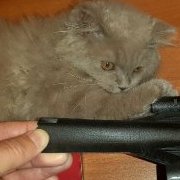
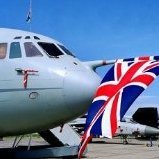
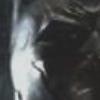
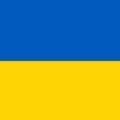
.thumb.jpg.d17ff607fc7e89ed057e63fcb6f2a888.jpg)
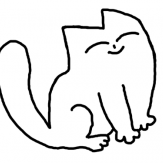
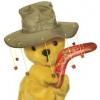


.thumb.jpg.d3635a7ef6507d35f372dd09671fe96f.jpg)


